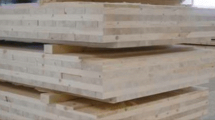Abstract
This study presents an experimental investigation of fatigue in wood subjected to tension perpendicular to the grain. The study has been designed with special reference to the influence of the frequency of loading. The investigation reveals an interaction between number of load oscillations and accumulated time under load to failure. This interaction corresponds to frequency dependent fatigue. Current models for damage accumulation and failure modelling are screened with respect to their ability to account for such “two-source” damage. The Damaged cracked viscoelastic material model proved to give a good basis.







Similar content being viewed by others
References
Bach L (1967) Static fatigue of wood under constant strain, Information Report VP-X-24, Canadian Forest Production Laboratory, Vancouver
Bach L (1973) Reiner–Weisenberg’s theory applied to time-dependent fracture of wood subjected to various modes of mechanical loading. Wood Sci 5(3):161–171
Bach L (1975) Frequency-dependent fracture in wood under pulsating loading. In: FPRS-Annual meeting Proceedings, June 15, 1975’. Portland, Oregon, USA
Barrett JO, Foschi RO (1978) Duration of load and probability of failure in wood. Part I. Modelling creep rupture. Can J Civ Eng 5(4):505–514
Bonfield PW (1991) Fatigue evaluation of wood laminates for the design of wind turbine blades, PhD thesis, University of Bath
Clorius CO, Pedersen MU, Hoffmeyer P, Damkilde L (2000) Compressive fatigue in wood. Wood Sci Technol 34:21–37
Cox DR, Oakes D (1984) Analysis of survival data. Chapman & Hall, London
Dugdale DS (1960) Yielding of steel sheets containing slits. J Mech Phys Solids 8(11):100–104
EN 1995-1-1 (2007) Eurocode 5: design of timber structures—Part 1-1: general—common rules and rules for buildings
Foschi RO, Yao ZC (1986) Another look at three duration of load models. In: 19th CIB/W18 meeting Florence, Italy, CIB-W18/19-9-1
Gerhards CC, Link CL (1986) Effect of loading rate on bending strength of Douglas-fir 2 by 4’s. For Prod J 36(2):63–66
Liu JY, Ross RJ (1995) Energy criterion for fatigue strength of wood structural members. In: Proceedings of the 1995 ASME meeting, Mechanics of Cellulosic Materials, Los Angeles, vol AMD 209/MD 60, pp 125–133
Nielsen LF (1979) Crack failure of dead-, ramp-, and combined loaded viscoelastic materials. In: Proceedings of first international conference on Wood Fracture, Banff, Alberta, Canada, August 1978, pp. 187–200
Nielsen LF (2000a) Lifetime and residual strength of wood subjected to static and variable load. Part I: Introduction and analysis. Holz als Roh- und Werkstof 58:81–90
Nielsen LF (2000b) Lifetime and residual strength of wood subjected to static and variable load. Part II: Applications and design. Holz als Roh- und Werkstof 58(3):141–152
Pedersen MU, Clorius CO, Damkilde L, Hoffmeyer P (2003) A simple size effect model for tension perpendicular to the grain. Wood Sci Technol 37:125–140
Philpot TA, Fridley KJ, Rosowsky DV (1994) Energy-based failure criterion for wood. J Mater Civ Eng ASCE 6(4):578–594
Reiner M, Weisenberg K (1939) A thermodynamic theory of the strength of materials, Rheological Leaflet
Rice JR (1967) Mechanics of crack tip deformation and extension by fatigue, fatigue crack propagation, ASTM STP 415:247–311
SAS Institute (1994) SAS/STAT User’s Guide, GLM-VARCOM, vol 2. SAS Institute, Cary
Acknowledgments
The publication of the work laid forward has been made possible by The Danish Research Councils hereby recognized for the financial support given through the research project “Modelling the effects of moisture and load history on the mechanical properties of wood” (grant no. 991363).
Author information
Authors and Affiliations
Corresponding author
Rights and permissions
About this article
Cite this article
Clorius, C.O., Pedersen, M.U., Hoffmeyer, P. et al. An experimentally validated fatigue model for wood subjected to tension perpendicular to the grain. Wood Sci Technol 43, 343–357 (2009). https://doi.org/10.1007/s00226-009-0244-7
Received:
Published:
Issue Date:
DOI: https://doi.org/10.1007/s00226-009-0244-7




